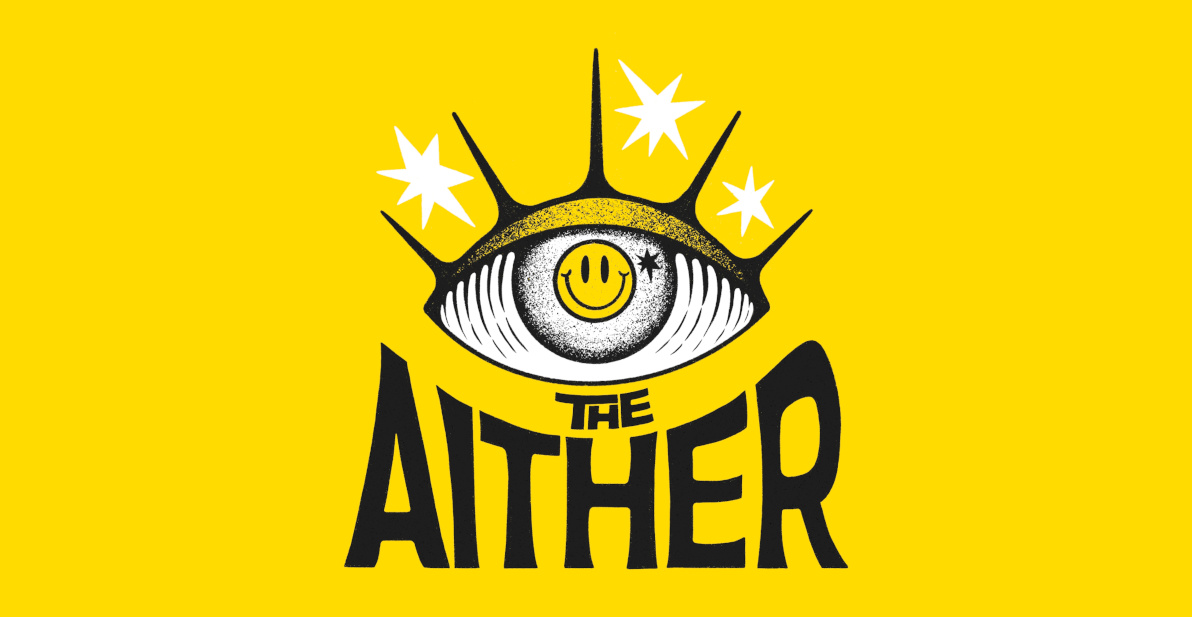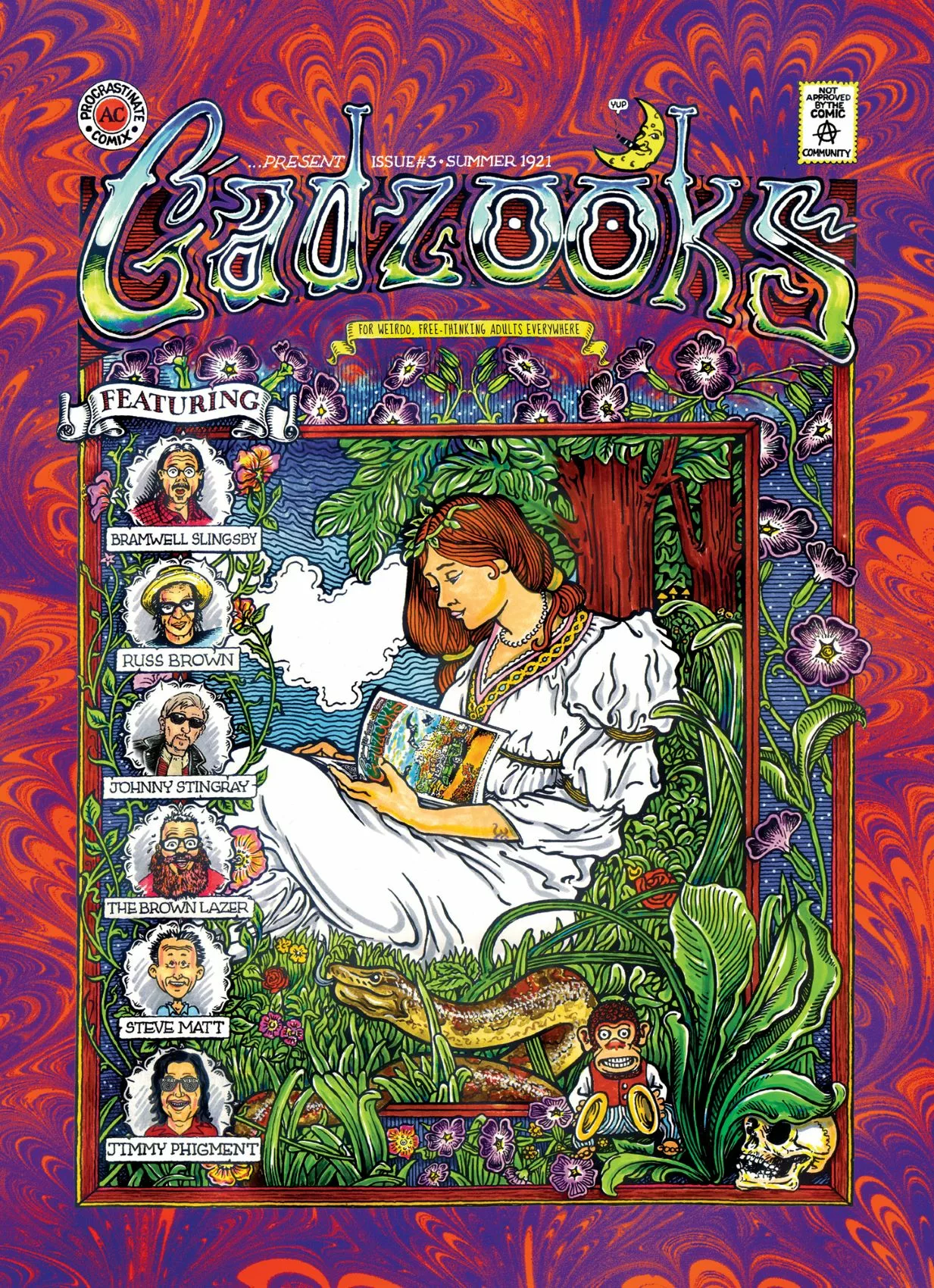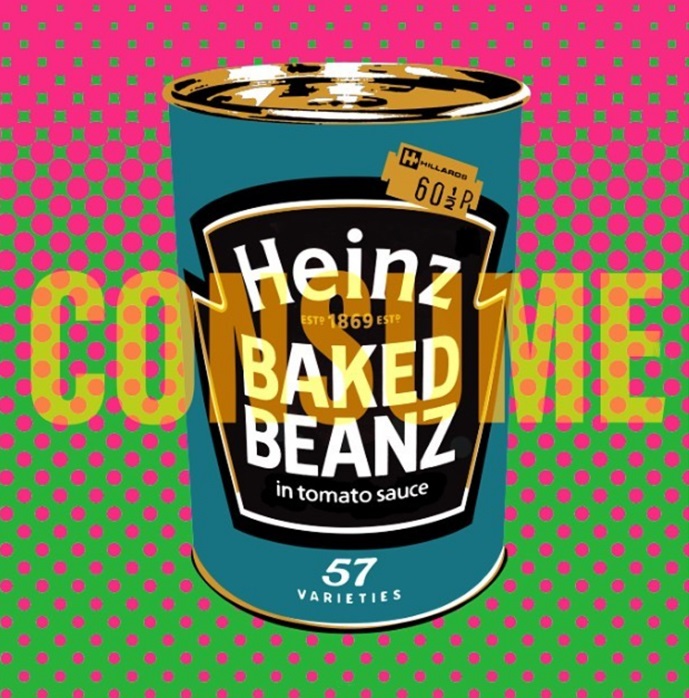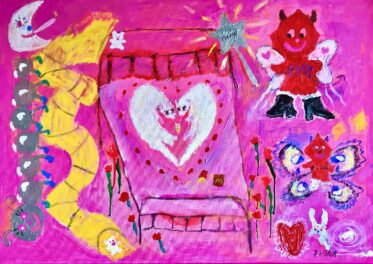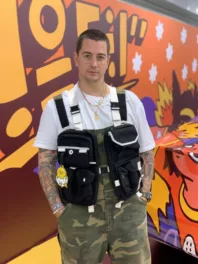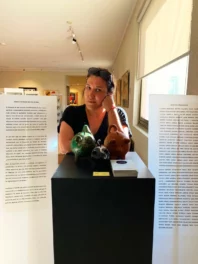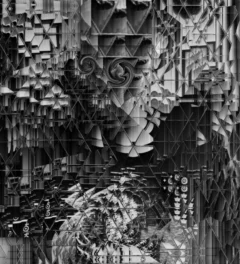‘Gadzooks’ is a new British underground comic magazine founded and published by J. Bramwell Slingsby. Harking back to the classic underground comics of the 1960s and 70’s, ‘Gadzooks’ features comics from J himself along with artists such as Russ Brown, Johnny Stingray, The Brown Lazer, Steve Matt and Jimmy Phigment.
Indeed. with it’s hand drawn art, left leaning vibes and outre themes – You can practically smell the bong water, patchouli and incense flowing forth from every page of ‘Gadzooks’.
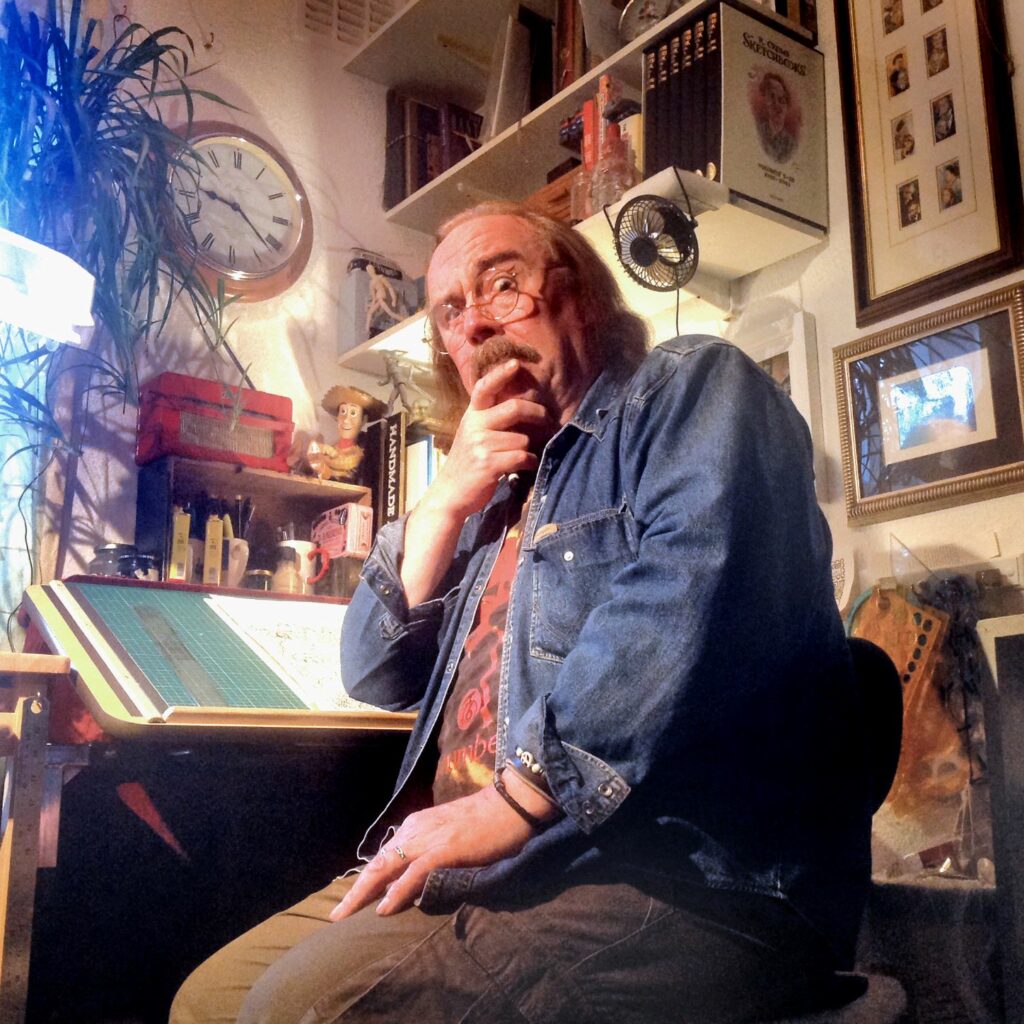
Summarising ‘Gadzooks’ himself, J states,
“Gadzooks are modern-day, traditionally hand-drawn, independent, underground comix. With its classic hand-crafted and adult-themed art; it is continuing in the legacy of the alternative comic styles of Robert Crumb, Gilbert Shelton and the whole gang of counterculture comix artists of the 1960s and 70s.
Their scratchy lines, immersive detail, left-field subjects and bizarre, colourful characters gave a visual voice to the feelings of a generation, and Gadzooks is proud to help keep that spirit alive and bring it into the future.“
Wanting to get to know more about the magazine and it’s publisher, we sent J some questions to answer over email.
Check it all out below…
Getting Acquainted
Name + D.O.B?
J. Bramwell Slingsby.
Born in the miserable month of January, 1961
City, State and Country you currently call home?
I’m currently living in the historical (but slightly gaudy) city of York, capital of Yorkshire, UK.
City, State and Country you’re from?
I was originally from the microscopic, semi-rural market town of Bingley in West Yorkshire, UK.
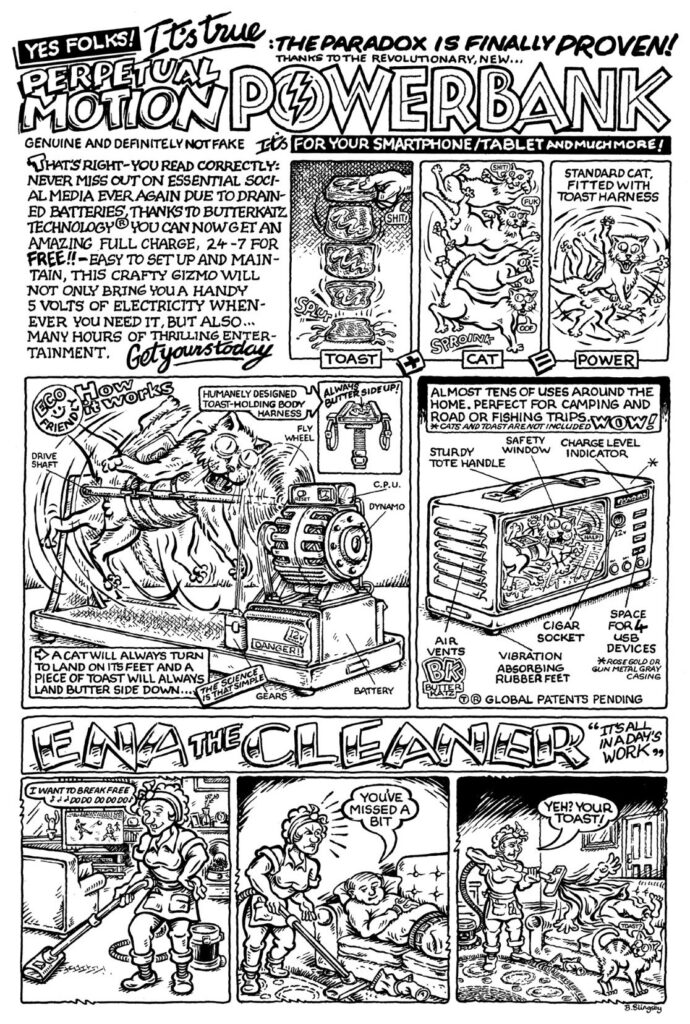
Firstly, can I ask why you chose to release a laborious, hand-drawn, printed ‘variety’ comic in an age where the market is dominated by glossy graphic novels and digital delivery?
That’s a very interesting question.
It stemmed from my own desire and excitement for physical comics with folding pages. We’ve all seen the rise of interest in analogue recordings – vinyl and now: cassettes – and I realised that I might not be alone in hankering after the traditional.
Yes, it’s more work to create but I think that’s what gives those older comics their value; when you can actually see the inky scratches on paper and know that every single line was carved by the artists hand.
It seems I was right as the first edition of the first issue sold out in just four weeks with copies going as far afield as California, USA. I have no plans to release the comic as a digital download. I think that would be counter-intuitive.
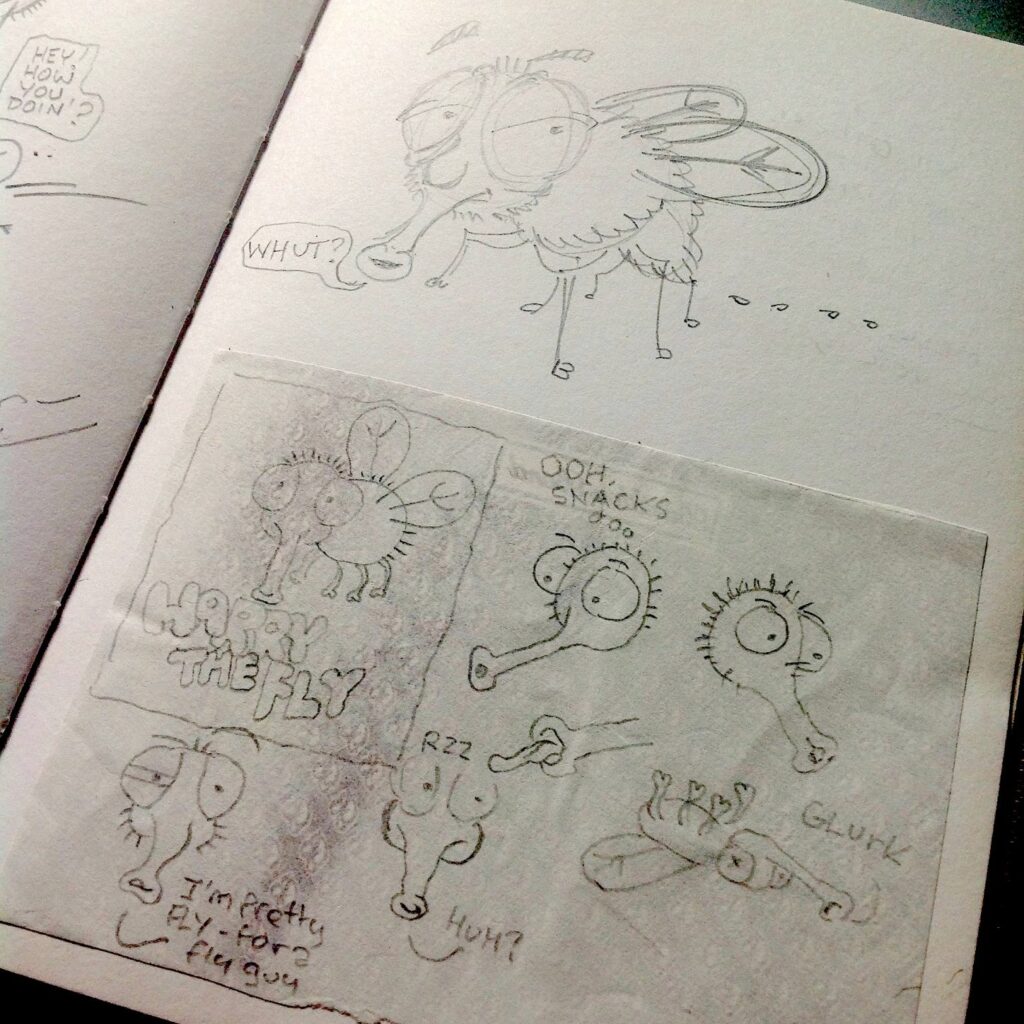
When and why did you first become interested in art, comics, writing and everything creative?
Were there any pivotal creative moments or influences?
Just about every member of my family were artistic, creative or involved in crafts of one kind or another and, growing up, I thought that all families were like this.
Apart from the comic books which were always in the house; both mine and my older brothers’, there were animated cartoons on TV and at the cinema which totally absorbed me as a child. Disney was a big influence but even back then I felt their stuff lacked a little ‘oomph’ as everything was well drawn but the characters were, to me, too ‘nice’ and the stories too ‘limp’.
I was particularly captivated, and preferred, the likes of Tom & Jerry with its slick, ‘silent comedy’ slapstick and hot jazz as well as the cast of Warner Bros characters with their snappy dialogue and voices.
Later, there was the Hannah Barbera characters which I thought were terrific for the storylines but less so for the stylised artwork.
In Junior school I had devised a cunning scheme to make a little money: I would trace pictures of those characters or draw my own silly comics and sell them for pennies (usually to the girls in the class).
It was then that I realised that it might be possible to do this as a job.
The first piece of art I bought was around the age of ten. I’d seen a print of Ed Mandon’s ‘Song of the surf’ in a second hand shop and asked my dad to borrow the £2 they were asking for it, as I ‘had to’ have it.
I just fell in love with the spacial energy and the mood it conveyed and I was in awe that a painter could evoke such photographic realism. I still have it today.
Who are some of your favourite comics makers, artists, musicians and writers?
…and what is it about their works that so inspire and move you?
From the American comics I very much admire the work of Mort Drucker, Robert Crumb, Art Speigelman and Gilbert Shelton. Their styles are so admirable both in terms of graphical technique and story telling.
The Fabulous Furry Freak Brothers is a hilarious concept. They are like a dysfunctional family in a hippy sitcom. Franklin is the father, Phinias is the mother, Freddy is the son and his cat is the baby.
Tom Paterson and Robert Nixon are two names who shine out from the British comic scene for me as do Mary Tourtel and Alfred Bestall, who drew Rupert Bear, for those amazing landscapes and settings with such a painterly style.
However I am also particularly inspired by the work of the 18th and 19th century engravers and satirists.
Bernard Baron was an engraver, often working alongside William Hogarth, who really mastered the method of rendering tones with cross hatching. Just exquisite to look to it.
George Cruikshank’s and James Gillray’s social commentaries are also a great influence on me, with their impudent scenes and stylistic portrayal of character types. I see these artists as very much the founders of modern comic art.
Music is very important to me and my tastes are very diverse. In a single listening session I can go from Ravi Shankar to AC/DC or Chet Baker to People Under The Stairs.
I listen to a lot of Little Feat, Humble Pie, DJ Mr Scruff, and Ozric Tentacles (man, I love that band) and at the moment I’m listening to a lot of a new British band called Dirty Sound Magnet – they’re well worth checking out.
If art is how we decorate space then music is how we decorate time, and when I’m drawing I always have something playing.
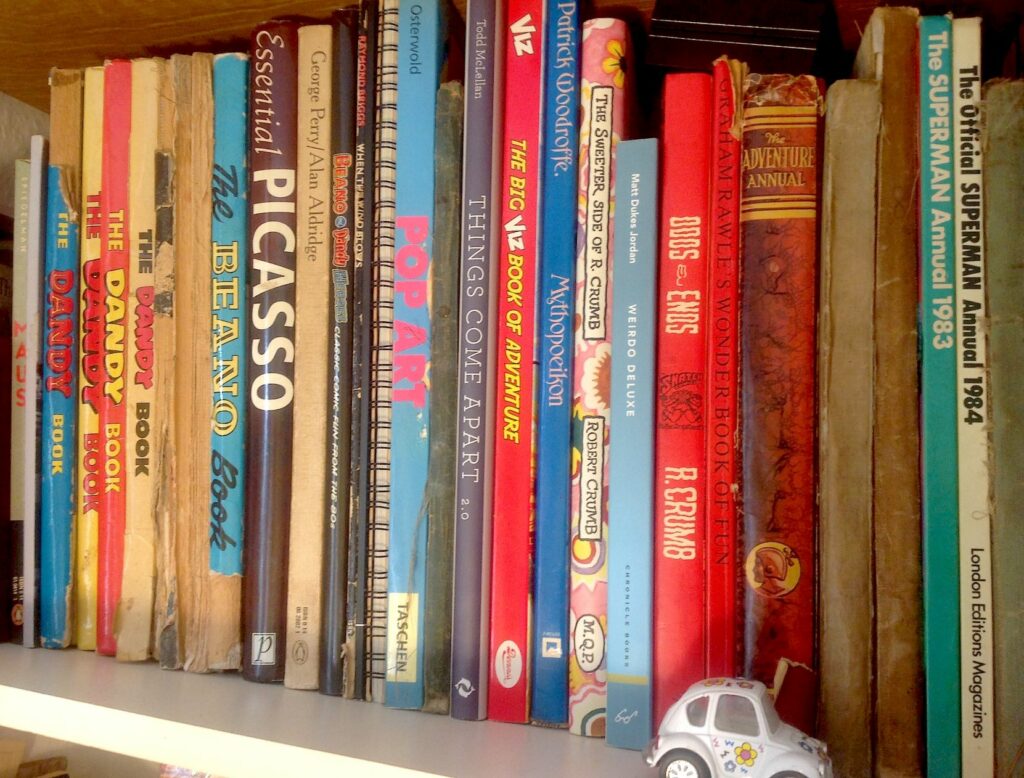
Please describe your usual process for creating and curating an issue of ‘Gadzooks’: From creation to eventual completion?
The best ideas can be sketched on the back of an envelope and will look great. If the idea is good, any realisation of it will be sufficient to carry it to the observer.
This is an approach I learned from advertising: it has to start with a strong idea. This could be a story, a gag, a character or setting. I spend more time thinking of what my characters might ‘do’ or how they might talk than I actually do drawing them (that’s the easy part).
I have sketchbooks, and when an idea hits me (it could be 3 in the morning) I jot it down as concisely as I can, sometimes just as a phrase, for me to go back to later and develop.
From that I then decide if it only warrants a three, four or six panel telling or if it needs a whole page or more. I’d start with the dialogue, which gets broken into panels, then I figure out which parts of that dialogue have more interesting visuals attached to it.
For example: two talking heads are less visually interesting than a fist fight. Those panels then get pencil sketched for proportion and layout and eventually mapped out, mathematically onto a huge board, 402mm x 297mm.
The last stage is refining the pencil work and finally: the laborious inking work.
Recently, I’ve been inviting some terrific artists whose work fascinates or impresses me (and whom I think would fit with the overall vibe of the comic) to contribute to its pages. Among them: Russ Brown, Johnny Stingray, Stuart ‘Brown Lazer’ Bell, Stephen Matthews, and James Phigment.
Their brief has been completely open: take as much space as you like to draw whatever lights your fire. When everything is completed I put on my graphic designer’s hat and begin assembling it in publishing software to see how the different pages flow the best.
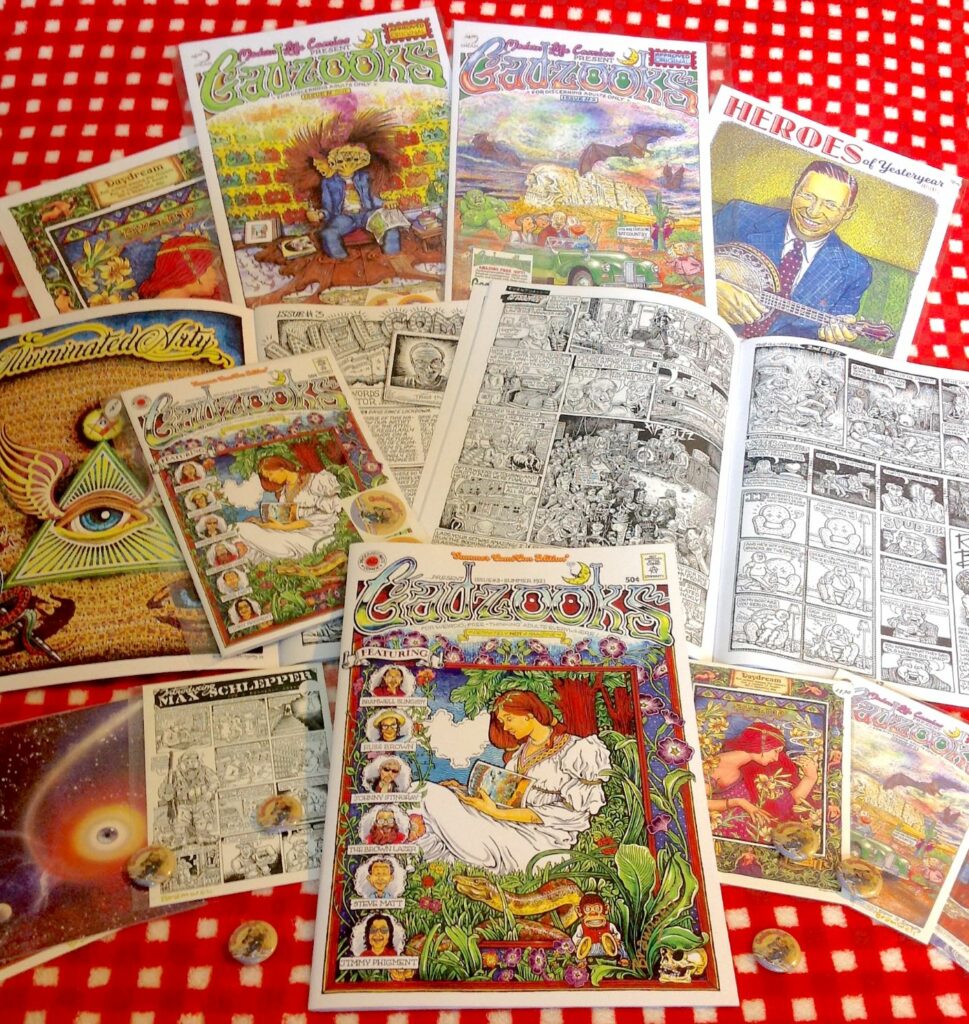
If people wanted to work with you or buy some of your art and wares – How should they get in touch and where should they visit?
At the moment, as it is still growing, I’m having to rely on some pretty low-key websites and socials. www.gadzooks.bigcartel.com/products is the shop page which gives a little overview of each comic and there’s an Instagram page which is very active @myscreenidols and a Facebook page @gadzookscomic which is less active.
As there is just me running the whole show out of a suitcase under the bed, I can be reached at any of those places.
Are there any upcoming projects you would like to mention?
A few of my stories are about to be featured in a ‘psychedelic edition’ of a major American anthology: Headache Comix, which is pretty cool. It’s being curated, I understand, by Scott Levine and Dennis Lindfors – with contributions from Denis Kitchen (of Kitchen Sink Press).
I was approached, and naturally said “yes please”.
I’m also working on the next issue of Gadzooks which should be available early next year (I gave up with deadlines when I quit the advertising scene. Too much stress.)
I’m also working on a set of large, gallery, art pieces called ‘hidden’ which explore the human side of social media.
What about your backstory?
Please describe some memories – such as art, comics, music, friendships, adventures, study, romance, politics, work, crime, religion from the stages of your life noted below:
* Childhood:
My childhood was filled with art, crafts, music and creativity in general.
Both of my Grandfathers were competent artists in their spare time and one of them was a also a concert flautist. My dad was superb at pencil drawing, and because of them all I just grew up thinking that this is what everyone did.
My early childhood sounds to me now like something directly from Swallows & Amazons.
I lived not far from a large, natural parkland. It had meadows, banked woodland and a river at the far end. Me and my friends would spend the summers swimming in the river and climbing its rapids or building rafts from scrap wood to sail over to the small island in the middle.
When we weren’t doing that we’d be adventuring among the woods, building fires and falling out of trees.
Sometimes we’d venture up the hills to the moorland and roam about, annoying the sheep.
As part of my allowance (or ‘pocket money’ as we called it) I used to get a weekly comic or three.
From as early as I can remember I was reading The Beano, The Dandy and The Beezer. I had an older brother, so I had quite a back catalogue to delve into as well.
Whilst I loved the art in those publications there is one character which still holds a very strong place in my heart and that is Rupert The Bear.
I think the Rupert stories were always the epitome of fantasy. Whereas the Dandy tales were limited to a simple ‘set-up and punchline’, Rupert’s tales were convoluted and had a clear plot arc, which involved some impossible scenarios but which always got him home safely before teatime.
I identified with him the most.
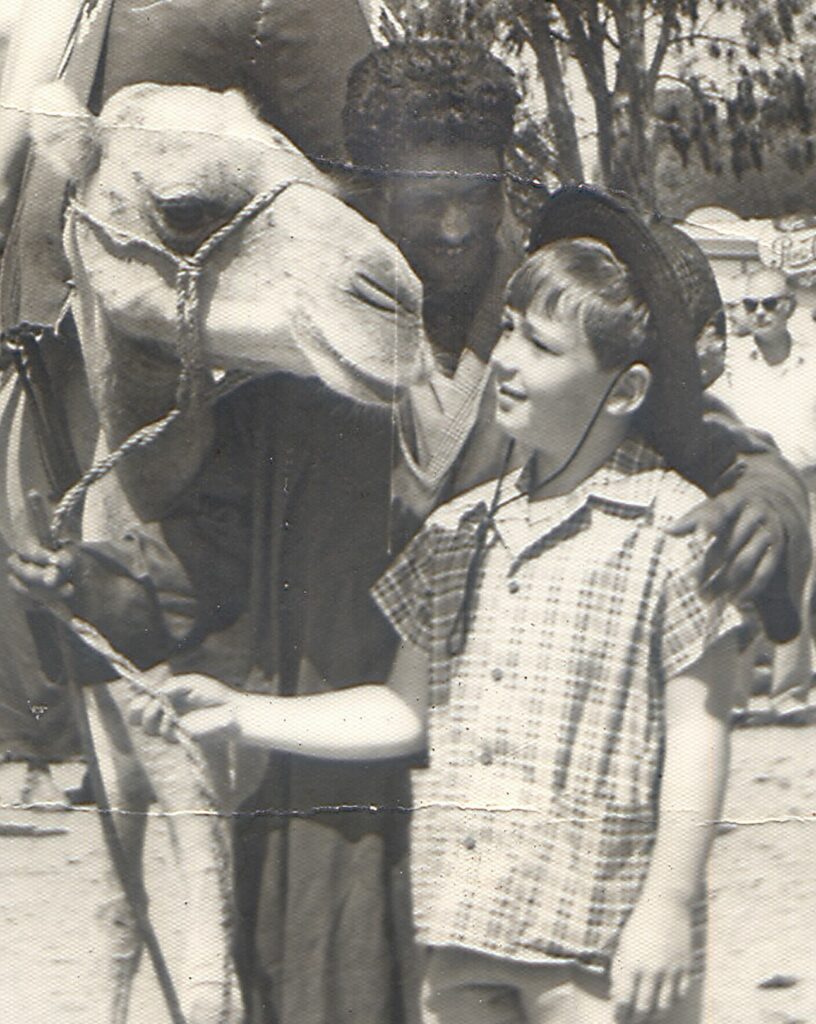
* Early teenage years:
I think my dad wanted me to follow him into the family plumbing business but my head was too far in the clouds for that.
I actually wrote to the Disney Studios in Burbank, sent them some drawings and asked how I could get to work for them. Amazingly, they wrote back to me and said to continue with my art, go to art school and study “real hard” then get back in touch with them when I was a little older.
This was all I needed to hear.
High school was not a great experience for me as the school I was at was not geared to ‘neuro-divergent’ types like me.
I was crap at maths but excelled at language, art and other manual skilled subjects like woodwork and (what was then called) technical drawing.
I had lost interest in being ‘studious’, partly as I’d also become friends with kids who were mostly older than me.
When I was 14, my older brother took me to see Alice Cooper at Wembley, London and I was hooked on this thing called ‘rock’.
Me and my best pal began sneaking in to the local bars and going to rock gigs in Bradford, where they had a major, tour circuit, concert venue. In the following years I must have seen all the iconic bands of the 1970s, many of them: multiple times (*coughs* Black Sabbath – the Ozzy years).
* Later teenage years:
I left school with just enough qualifications to scrape into Bradford College of Art.
My goals had been shaped a little and I dreamed of being an ‘album cover artist’ like Rick Griffin, Storm Thorgurson, Roger Dean or Patrick Woodroffe. These guys were like rock stars to me.
The course I was on however was steering me towards the world of advertising, which, to be fair, was a safer option for a regular income. I thought.
At art school I studied fine art (under Frank Johnson, who had taught David Hockney), cold metal typesetting, signwriting, photography and animation among other things and also fell in love with pop art, art nouveau and the poster art and Soviet modernists of the early 1900s. I particularly liked El Lissitzky and Kazimir Malevich.
All of my contemporaries at that time were getting high on hash and black microdots or mushrooms and it kind of rubbed off on me, a lot. *winks*
There was a couple of ‘head shops’ in town where you could buy incense, tie-dye clothes and of course – underground comics. I had found my ‘happy place’. Here were subversive comics which spoke to me like an adult. Not only was the standard of art fascinating to me, but the subjects often hit on topics like politics, environmental issues and social commentary, spiritualism as well as wild sex.
It was something of an awakening.
Between the summer of 1977 and 1979 not only did I have a weekend job in a record shop (my favourite job ever), I was also, when I could, roadying for the band Hawkwind. This sounds far more glamorous than it actually was. Basically I was an itinerant labourer, paid a day rate for lifting and shifting.
BUT I got to hang out backstage. Man! happy times.
Before the internet it was difficult to get information without reading and researching magazines and books but I tracked down the address of Greenpeace. I’d read that they were calling out for volunteers to help crew the Rainbow Warrior as it set sail to the South China seas. They replied telling me which British port to be in and at what time and date if I was seriously interested.
Sadly, it coincided with the Reading Rock Festival (which I’d already got tickets for) so I silently declined the offer.
Sliding doors, man. Story of my life. But I had a bubbling social and political awareness building up in me.
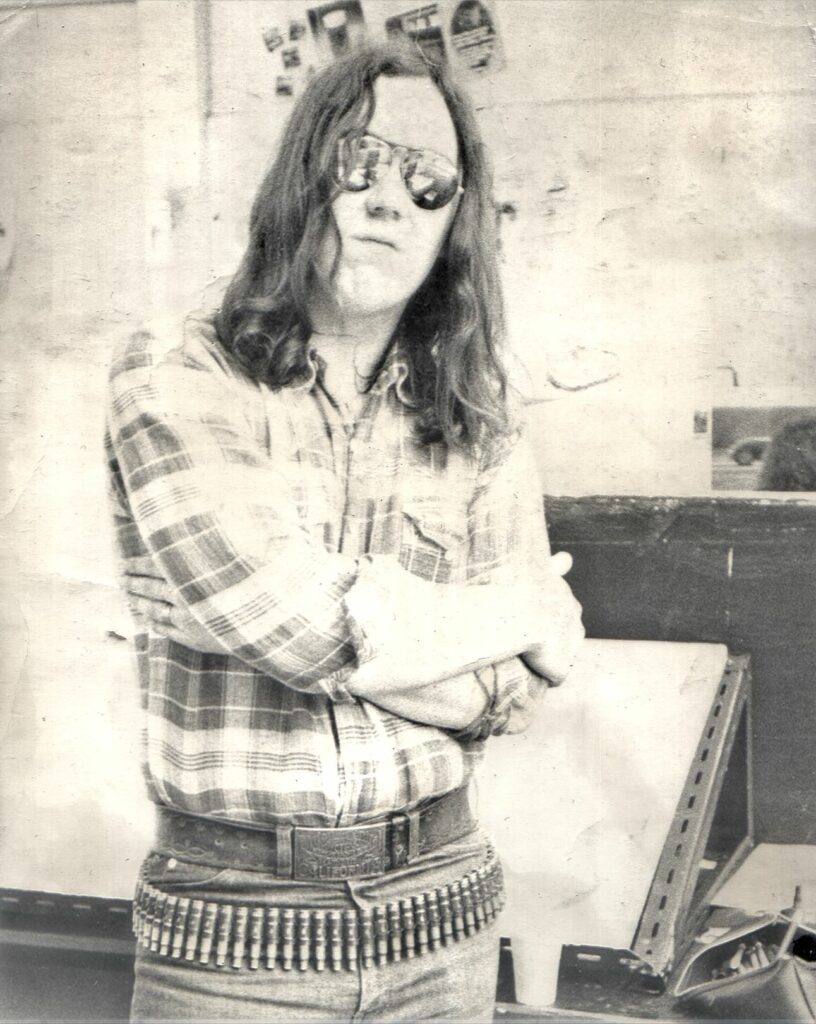
* Your 20s:
It all began to happen very quickly in my 20s. I stumbled into work and before I knew it I was locked into the 9-5 purely for financial reasons.
I’d left home at 17 and had ‘lodged’ in variety of friends attics and spare rooms but now, I had a wife and a house and a whole backpack of responsibility.
That first ‘proper’ job was in the art studio of a national supermarket chain’s head office so I was surrounded by old-timers who could do exquisite hand lettering, of the old-school advertising style. I just soaked that stuff up, but having my own comic was still there – nagging at me to get drawn. I made a start by creating a few splash pages and character sheets and so on, but the following years saw those get filed under ‘later’ in a leather portfolio, which disappeared under children’s toys in time.
Politically and spiritually, I kind of got quite busy, however, in those times. I became a vegetarian, I was a member of various groups such as Greenpeace, Friends of the Earth, CND and so on and was also a Sanyassin of Bhagwan Shree Rajneesh.
I was getting my ‘mind-altering’ kicks from higher sources by then.
Still a Hindu at heart to this day; it is the one most grounding and also elevating perspectives I have. Plus: I absolutely love Hindu art – the colours, the fantasy, the sheer scope of immersive detail. I draw a lot of inspiration from that now. I mean, come on: a four armed elephant! what’s not to love?
…Whoah – You were a Rajneeshee, we had no idea!
What led you to discover and embrace the movement?
…and can you share with us the impact of Rajneesh on your art and life?
Are you still a follower?
It’s dangerous ground discussing spirituality, particularly in context of art and culture but as it did have a profound effect on my perspective and view of the world I don’t mind sketching out a bit of a timeline.
Growing up around Bradford, which had a large population of Indian and Pakistani residents, it was hard not to be exposed to a wide variety of other cultures and religions. I used to see the girls and women with their henna tattoos and brightly coloured clothing a lot, as well as shop windows with icons such as Ganesha and Shiva in the windows.
I was reading about Buddhism from about 14 years old, partly through listening to the band Gong with its eastern references.
When I met my first wife she told me about friends she’d had back in Canada who followed this guru. We discovered that they had a centre not too far away and started visiting regularly.
I absolutely loved their meditation techniques and it opened up whole new channels of experience for me.
I was just so struck by how deeply happy these people were and just wanted to experience that for myself. I bought heaps of books and recordings of Bhagwan giving his daily talks and it was clear that he was a highly intelligent man with a ferocious sense of humour and I was captivated.
It started to tarnish a little after we’d been going a while and it was clear that it was not cheap to be ‘part’ of the movement. At every turn there were large expenses and it was relentless.
I also read more and more about the organisation and I had suspicions that it seemed to be being run by, usually, middle class, intellectual, wealthy Americans.
As it turned out, it was they who showered Bhagwan with Rolls Royces and helicopters, usually against his wishes, but that was all the media needed to brand it a ‘cult’ – one to be derided and shut down.
It’s tragic that it all ended so badly but it was probably inevitable.
Did you ever travel to Rajneeshpuram and if so – What was it like?
As Buddha said: “If you meet me on the path: strike me down. It’s not about me”.
These followers seemed to be holding all the power and wealth so I quietly drifted away from the organised side of what they were doing as it seemed to grow increasingly controversial. This would have been the mid-80s.
I never went to the Ashram in India as the costs involved were way beyond my reach and instinctively it just didn’t sit well for me. I heard a lot of first-hand stories which made it sound slightly dangerous to be honest.
Authority does not like ‘freedom’, they prefer conformity.
What are your opinions on the 2018 documentary about the movement, ‘Wild Wild Country‘?
I never saw the documentary you mention but I have seen others and they confirmed a lot of my suspicions.
It’s a shame, as he was a good man with some sound ideas (largely speaking, apart from some of the more outlandish ones!) about how to approach life and experience which I still hold close and practice daily.
Superficially, they’re obvious things like: how to fully experience the moment, letting go, and embracing all that is.
I don’t meditate like you’d typically imagine it, that was not his teaching; it’s taking a inner perspective and not projecting personal bias out into the world, and simply enjoying that silence.
Just to LOOK at a sunset, not ‘think’ about it, but to simply ‘experience’ it.
This is all probably more than you needed to know, but the experience gave me a particular view on life and an approach which is enduring. It’s not about religion (these views could apply to any faith), it’s about acceptance and gratitude. I’d add that I now distance myself from what the movement became but recall his words often.
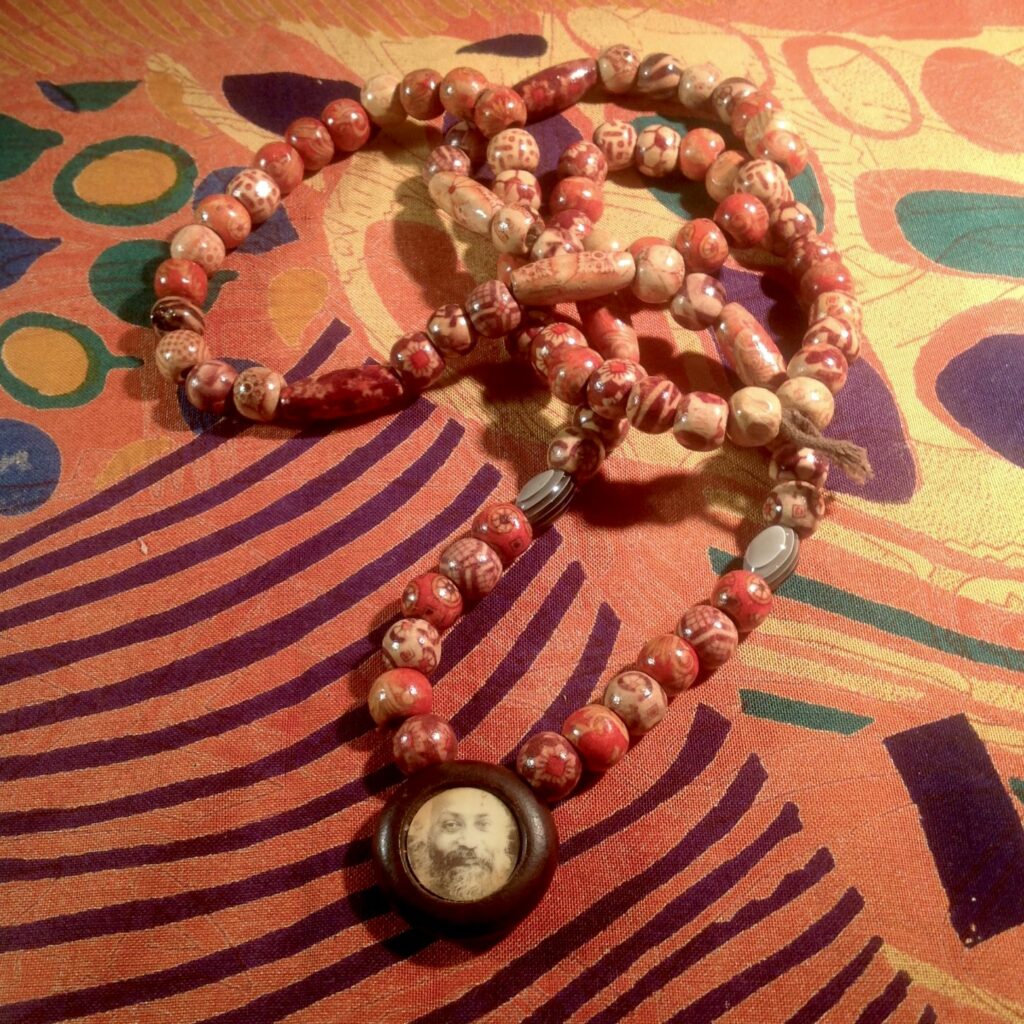
* Returning to the theme – Please explain some pivotal memories from your 30s:
My thirties were ‘the best of times and the worst of times’.
The first half of the decade saw me as the archetypal ‘yuppie’. I was a typical Ad Agency Art Director. The money was great and the lifestyle was greater, but the idea of drawing cartoons, to me then, was laughable. I could earn more in a week than a year’s worth of scribbling.
However, I knew that I could earn the big bucks if I got a job at Disney.
At the time they’d just opened an animation studio near Paris, France and were recruiting. I applied to be a ‘character development artist’ and got short listed! Would you believe?
I recalled the story of my early years in the application letter and whilst they thought my work was great, they said that I was up against some of the world’s greatest and had to decline, ‘this time’. They did however ask permission to keep my portfolio on file in their visual archive, so that, for me, was good enough.
The 90s were a very curious time for me which came crashing down over the course of a few brief years.
In short: my mother died, work was draining me and I began the slow slide into a full mental breakdown.
My wife sued for divorce, I got made redundant and I was left with nothing, alone in a one-room apartment with a suitcase of broken dreams.
Boom.
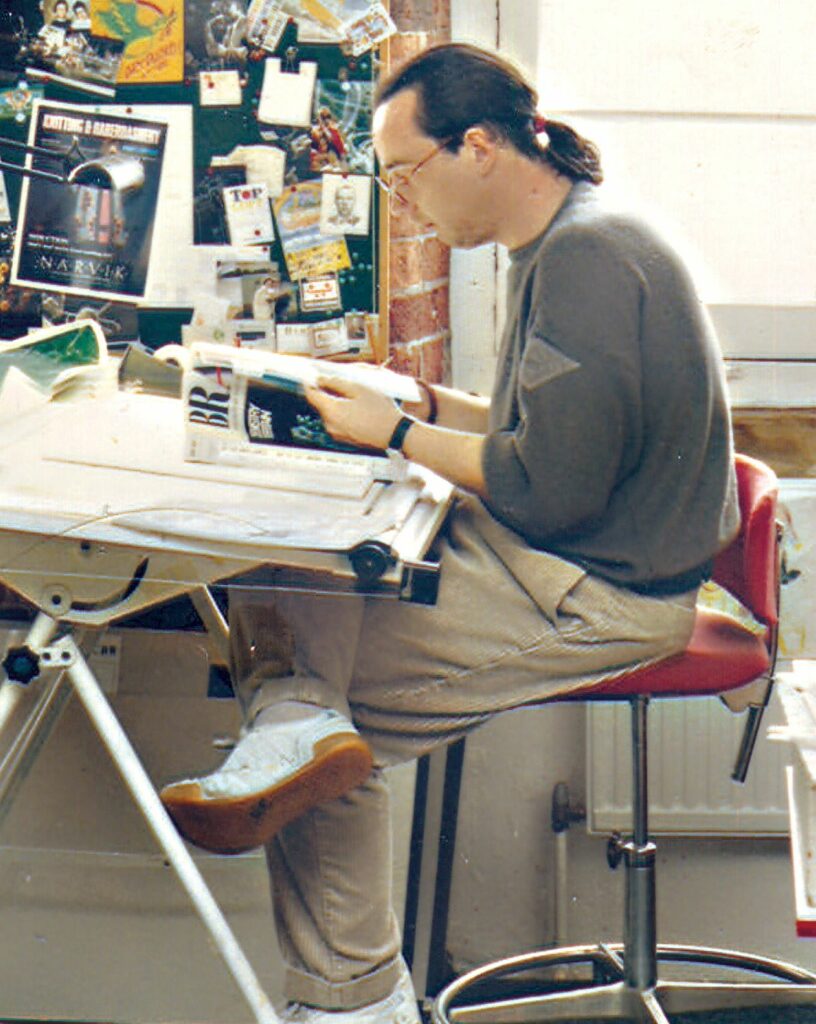
* Your 40s:
It took a few years to rebuild some kind of life.
With the help of a counsellor and a regular supply of Prozac I was able to come out of it wiser and from that I got diagnosed as bi-polar, low spectrum autistic and OCD with anxiety syndrome (at least I had a name for why I always felt an outsider now.)
Luckily I still had a relationship with my three children and I think that helped to give me a focus to carry on, but there had been times that it was hard to have any enthusiasm.
This was also the era that I’d returned to music as an escape.
I’d been pretty good at piano as a kid and later as a bass player in school bands as well as flute, but I always wanted to be a sax player. I became obsessed with Charlie Parker and Art Pepper and started lessons not only privately but also at Leeds College of Music.
It came very naturally to me and soon I was playing pub gigs, touring about with various bands and eventually recording a full album of original music.
By 2005 I’d started a trip-hop band and was loving that cross-over of old and new, beats and samples with a live band. But then, just as suddenly: I abandoned all hope of ever making it in music. I think I saw that with the changing landscape of media delivery (the growth of online digital sales versus the physical format) as well as the likelihood of getting signed by any label was just an unattainable quest.
I know when I’m beaten.
I sold ALL my musical gear and went into radio.
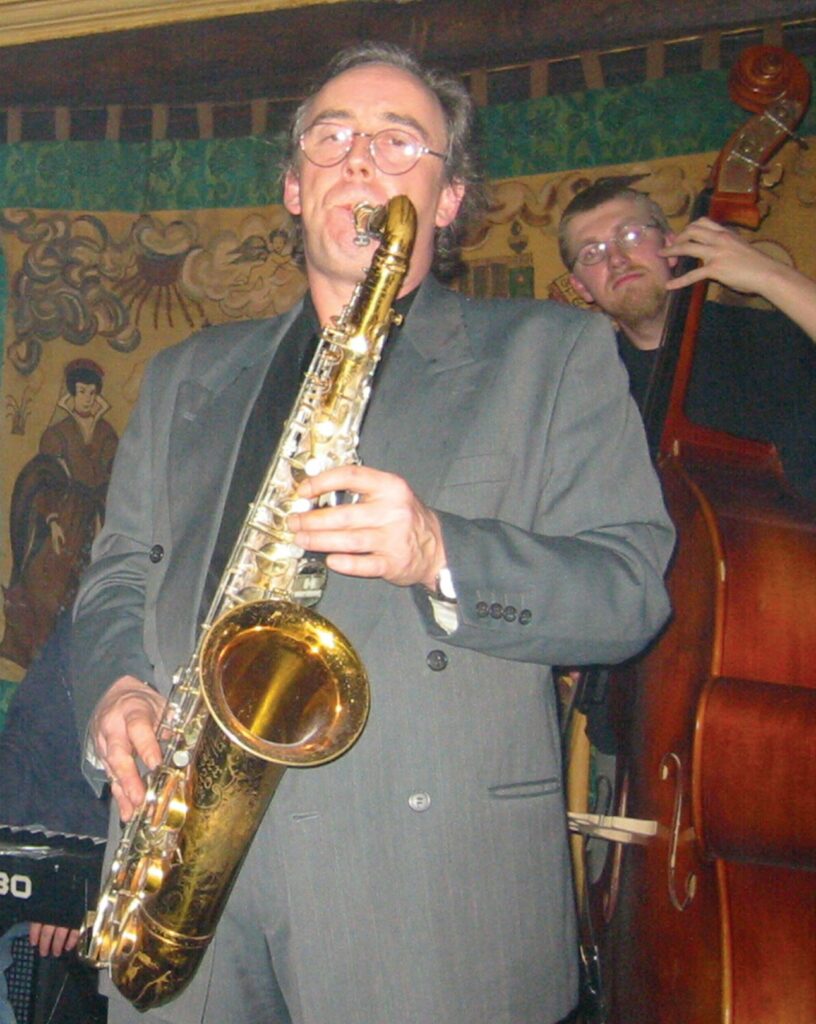
* Your 50s:
By this time, art, cartooning and any kind of artistic life was a very long forgotten memory, but radio was good for me.
I had a rock show and I loved the local bands music I’d play, I was good at interviewing and had (if I might say so myself) a pretty good radio voice and persona. I still had the drive to ‘create stuff’ but by that age I was the observer, the consumer; ingesting anything and everything I could which was innovative.
I actually wrote a book, around then, called ‘Valvepunks’ which was a time-warp comedy about an old radio presenter who built a time portal radio.
That became a twelve part, hour long radio show I created which ran for a year on a regional station and is still out there on iTunes I think as ‘Uncle Reggie’s Magic Radio’.
I had a little ‘day job’ in a local print shop where I could still stretch my art muscles on regular graphic design but it was ‘old hat’ to me now. I felt I was just going through the motions of being a designer.
That’s partly due to the fact that a possession of those skills, (earned the old fashioned way by analogue mentoring, apprenticeship and training) meant that typography, photographic composition, colour use and layout balance were part of my bloodstream. I didn’t know anything else.
Then, in 2014 I had a stroke.
To be strictly accurate it’s what they call a TIA or mini-stroke but to me it was just as devastating as a full blown event. I lost the sight in my right eye. Permanently.
In the hospital, at the time, I was completely distraught – I thought I’d never be able to draw again. The first thing I asked for as I lay in my bed was a sketchbook and pencils. My co-ordination was now shot, in my 2 dimensional world, and I forced myself to relearn how to make marks on paper.
So yeah, a half-blind recovering depressive.
Great starting point for an underground comix artist eh?
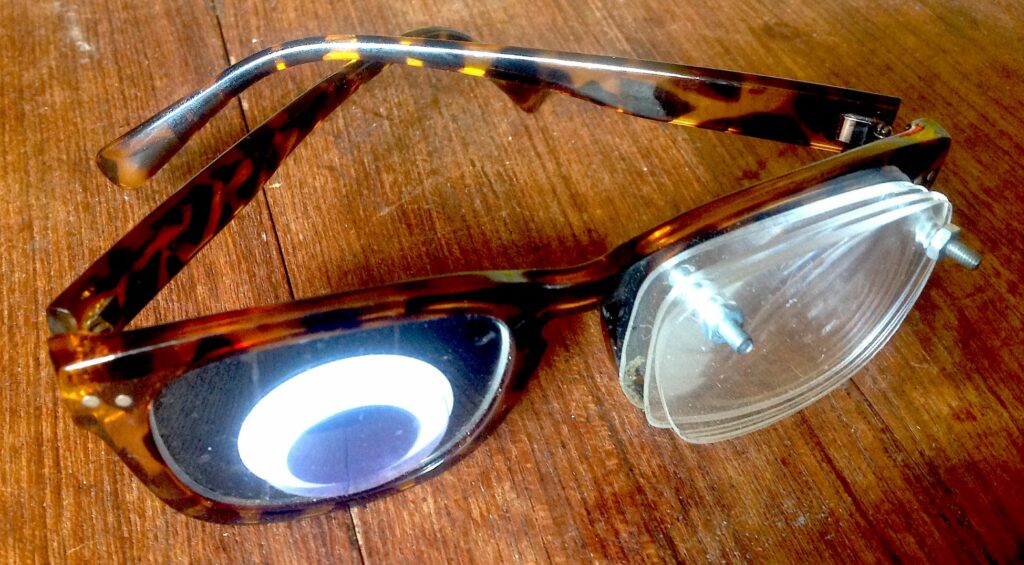
“These are the glasses I wear when doing the ink work. One lens is blacked out, as I don’t use it. The other is a home made contraption featuring three extra lenses bolted on so I can get in really closely.“
The recovery process was slow but I gradually perfected how to perform simple tasks, often by touch, until l’d mastered my new perception of spacial awareness.
My brain function is still not back to where it was and I sometimes have difficulty processing information and, certainly, remembering things.
Huge tracts of memory have been wiped forever, sometimes wafting back to me as a blurry dream sequence.
What this event did trigger in me was a rediscovery of drawing for two very key reasons: I had an inner drive to make it happen and also, when you view the world without 3D vision – everything looks like cinematic art, on a flat plane. Cover one eye and try it, it’s pretty cool to be honest
My real ‘epiphany’, however, began just after Christmas in 2017.
I always get seasonal depression and I’d been moping around wondering where I’d gone wrong all my life to not be in a position to make ‘physical art’ then a turnaround happened. I’d learned about screen printing at art school and the supermarket studio used it all the time for the shop posters so I started to invest in the equipment to begin printing.
All through 2018 I was in my element and must have turned out thousands of original art prints over a couple of years. I attended as many print fairs as I could and it was all going great and I was loving this new-found creative outlet but by February of 2020 it was all shut down.
For all of us.
The pandemic brought a halt to the world.
I was working two jobs at the time and I was laid off both of them, pretty much overnight. For a short while, I was in shock. It was like the world was asleep and I was retired.
It was a great time of reflection for me and I spent many days trawling though all of my possessions, eager to discover just who the hell I was and what had been going on all these years.
And then I found that leather portfolio with my cartoons in it, and remembered how it all started.
NOW I had the time to jump back in where I’d left off, nearly forty years earlier!
It was clear to me that I now had a huge backlog of ideas, life experience, wiser opinions and more tightly honed skills. I could not keep up with myself and I was turning out page after page whilst all the time listening to my reasonably large vinyl collection (a few hundreds – enough to keep me busy as I worked).
This was like nirvana to me.
As if my whole life had been waiting for this moment and I grasped it with both hands.
In just four months I’d created a 16 page zine and a 16 page full sized, hand drawn comic.
Some of my original art from the 70s and 80s feature in that first issue (but I’m not going to reveal which) as I was determined to literally pick up where I’d left off, plus, after all this time, I think it still worked as an idea.
My days were being spent listening to some terrific music, burning joss sticks, drawing and reflecting on life.
This was the beginning and permission I’d been waiting for.
(Some of J’s old screenprinting work.)
If you had to explain your creative endeavours to some recently crash-landed aliens, what would you tell them?
I’d have to assume that they had a strong understanding of my language and possess their own complex social and cultural systems, and then I’d say:
“I make marks on flat surfaces to prove that I existed. It’s known as the ‘Kickstone Phenomenon’.
Also, like all artists, I’m trying to reach out to other humans to show them how I see the world and by doing that, connect with them on a spiritual level and hopefully make them feel a little better, if only for a moment.”
I’d then say:
“You made a bad choice coming here, it’s not great. The planet is good but the people suck and will probably want to kill you.
So get back in your flying teapot and fly off to somewhere else as quickly as you can”.
If you could live in any place, during any historical era – Where and when would that be?
…and why would you choose that time and place?
If I could live in any time and place, I’d love to have been 17 in 1967, living in the Haight Ashbury district of San Francisco, just so I could experience that whole ‘Age of Aquarius’ culture shift first hand.
By 1970 I’d move to London where the music scene was in a state of massive change. That decade went from The Beatles, Pink Floyd and Jimi Hendrix to The Sex Pistols, The Clash and Talking Heads pretty damn fast, via glam rock.
What a time to be alive.
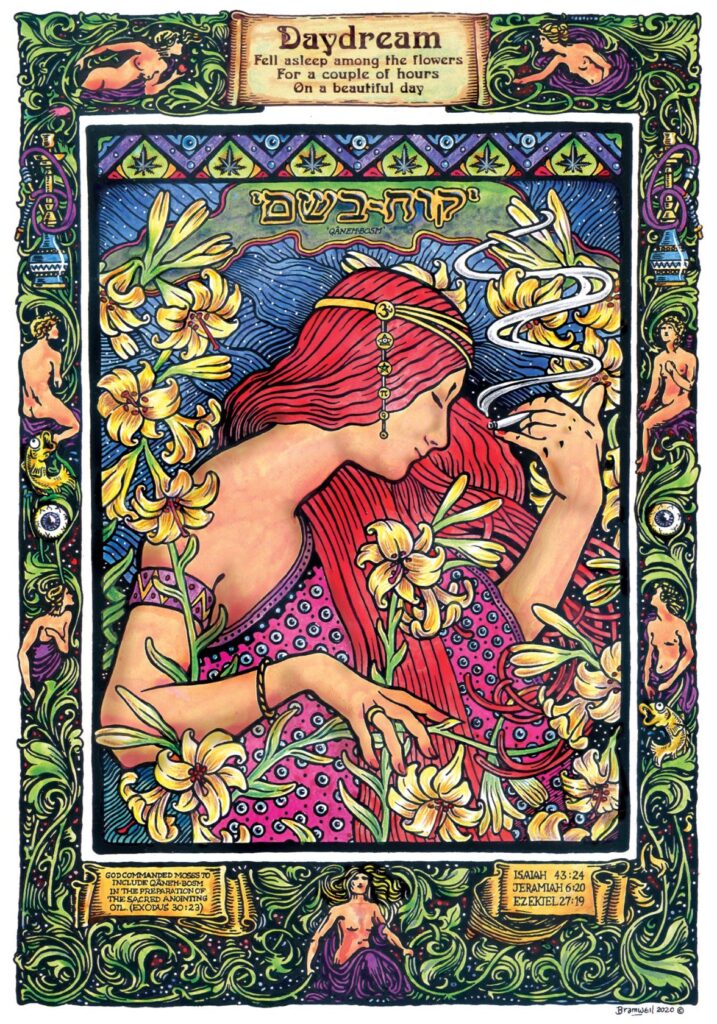
What role did toys play in your childhood?
Oh man, I used to make my own!
I was always building stuff, I loved those Airfix model kits and Meccano, plus; I’d make things out of cardboard and string.
I was totally into Action Man dolls too later on and also had a huge collection of model cars.
Weirdly, I became more like Sid Phillips in Toy Story towards the age of 10 as I’d recreate motorway crashes and quite literally set those cars on fire out in the yard. I was always breaking my stuff and glueing it back together in weird ways then watching it burn.
Yeah, my analyst was quite interested in that stage. Hah.
But here’s a thing.
My mum was a tailor and she made me and my friend, Mark, a Batman and Robin costume each. Around the age of 9 we would run up and down the streets, re-enacting some episode of the TV series we’d seen.
That was until my older brother (who was theatrically inclined and also always teasing and tormenting me) decided to dress as Cesar Romero’s Joker from the series. He emerged from the garage, chasing us.
We were genuinely terrified. We didn’t do it so much after that.
Yeh, toys were pivotal and essential in my young years.
My brother, although he visited often, left to join the army as a musician when I was about 6 so I grew up as a kind of ‘only child’, with imaginary friends and everything. I still have some of my old toys and must confess to buying cars and stuff occasionally.
The soul needs to play.
We shouldn’t deny it.
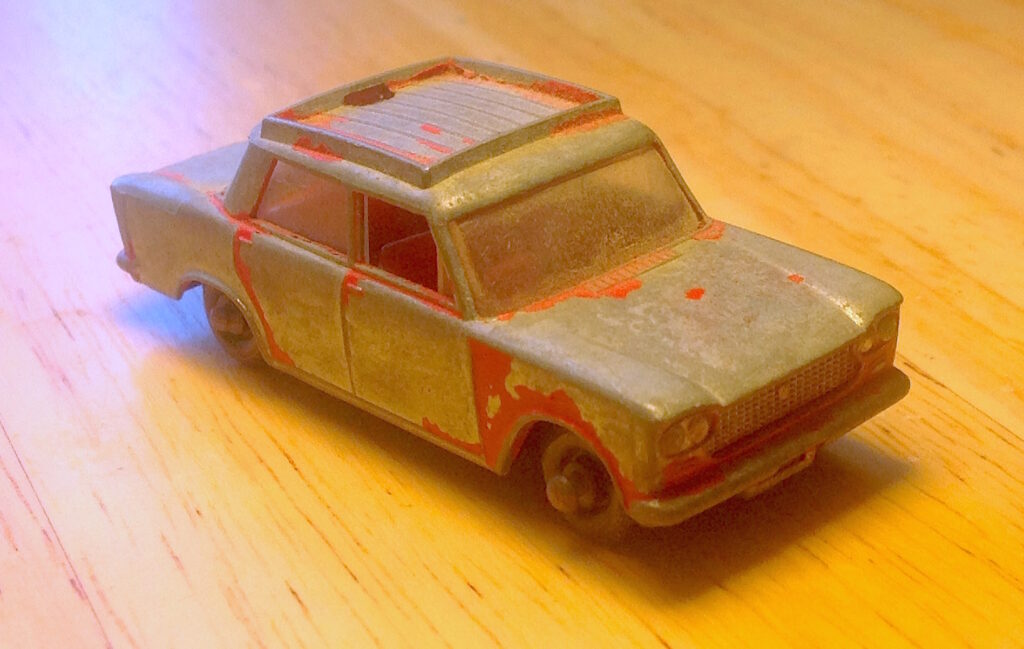
What are the top 3 items you own?
This is a difficult choice. I am both deeply attached and completely non-materialistic in equal measure.
However, I can certainly pinpoint some things which either inspire my imagination or which are very special to me.
World War II spy radio
One of my hobbies used to be restoring old valve radios and building crystal sets. I’m half way through my radio operator’s license.
I discovered this amazing little piece of history at a flea market and was immediately captivated by it. It’s a fully functioning, hand-made medium wave ‘crystal’ receiver built into the case of a pocket watch.
Hook one set of contacts to a copper water pipe and the other to a long length of wire (such as a prison camp fence) and you can hear the BBC. Absolutely no batteries required I’ve tested it and it works.
Isn’t science amazing!?
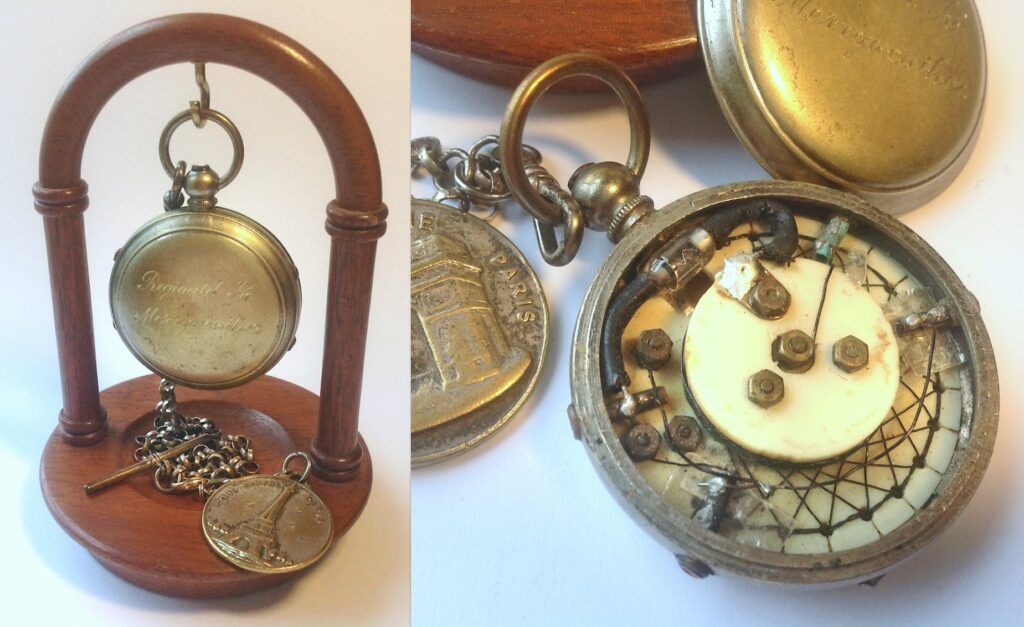
Nick Bantock, Griffin & Sabine trilogy box set
This was a gift from a very dear soul mate and it’s one of those items I’d crawl through a burning house to rescue, as they say.
If you haven’t read it I suggest you hunt a copy down. It’s an enchanting tale of unrequited love, adventure and mystery told through a labyrinth of exquisitely hand drawn letters and postcards from across the world.
These letters and postcards are ‘real’ objects within the book which you can unfold and handle. It’s just a truly inspired tale, beautifully realised and completely immersive reading.
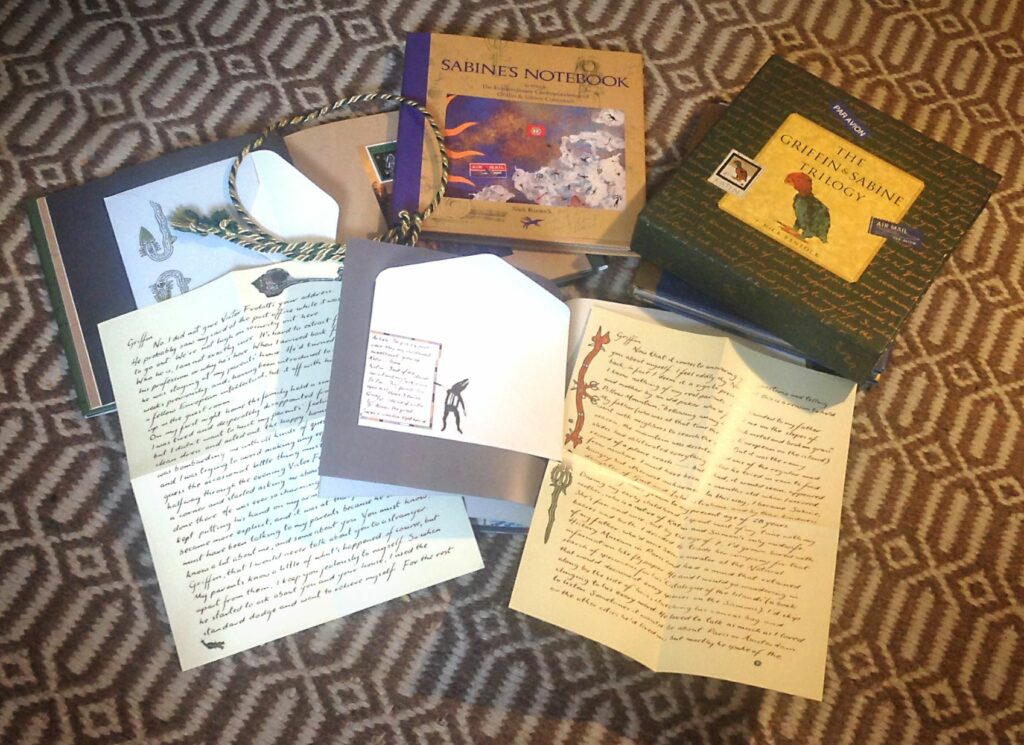
Lemmy’s bass string and autograph
On the night that Hawkwind played Bradford, St Georges Hall with Motorhead as support, me and my friend Ian decided to go together. This was before I worked for the band, but I knew the layout of the venue well.
After the gig we broke in to the backstage area and headed for the dressing rooms to get some autographs. We found Lemmy’s room, it was empty apart from trash and white towels but I grabbed a bass string from the floor. Searching further, we found him, out in the auditorium, overseeing the ‘strike-down’ of the gear.
We approached him and asked for autographs. I showed him the string and asked if I could keep it. “Give that ‘ere!” he said, “yeh, you can have that. It’s b*ggered”. We went on to hang out with him for a long while after, that night. He was a total ‘gent’. Polite, kind, very interested to make friends of his fans and hilariously funny.
Yeah. This is a very treasured item. I framed it all up with some of my ephemera from that time.
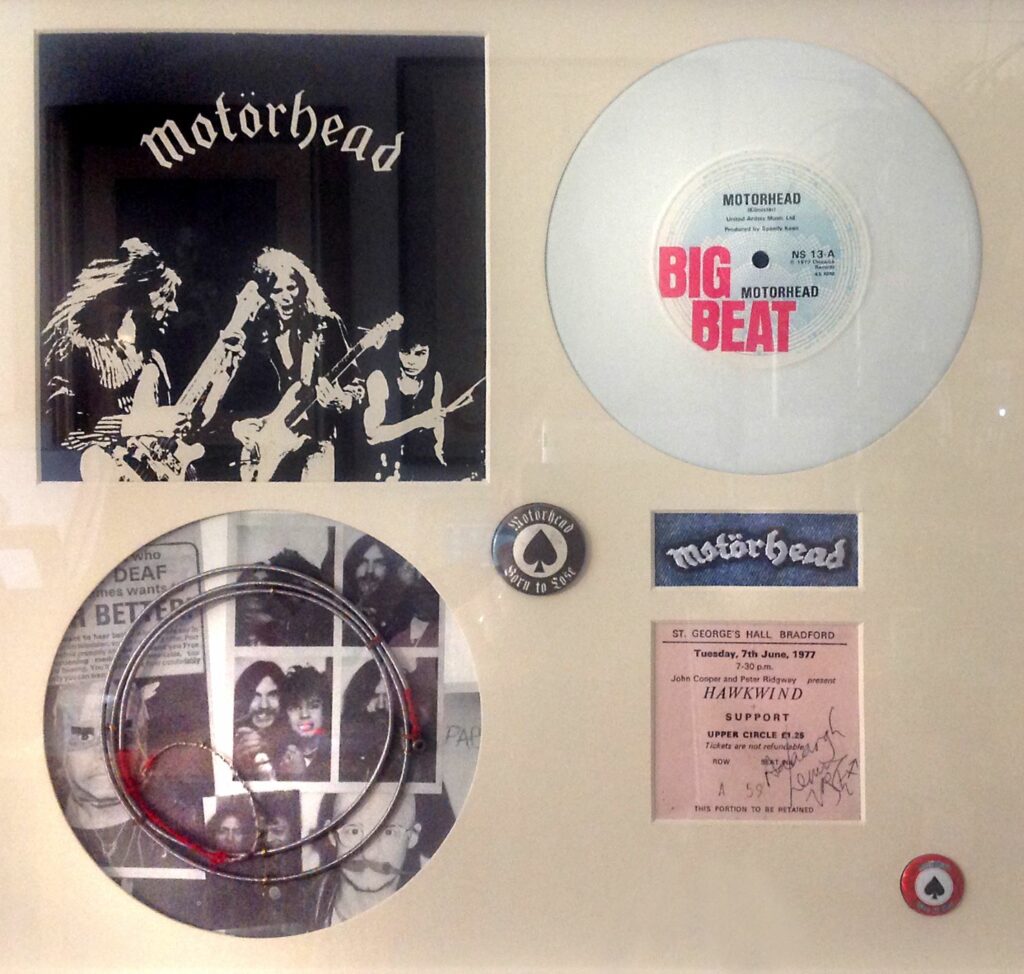
In a fight between the following iconic British comic characters: Biffo the Bear (created by Dudley D. Watkins) Vs. Judge Dredd (created by John Wagner, Carlos Ezquerra and Pat Mills) – Who would win?
…and why would they be victorious?
(Please draw the battle in all its violent beauty!)
Yikes. You want me to ‘actually’ draw something? My day rate is £500. HA!
But, theoretically, I’d have to say that Biffo would win by outsmarting Judge Dredd. It would probably involve custard pies or buckets of water tied up in trees but would almost inevitably end with a close up of a winking Biffo giving a thumbs up with Dredd sitting on the floor in the background behind him, cross-eyed, holding his lumpen head with stars spinning around it.
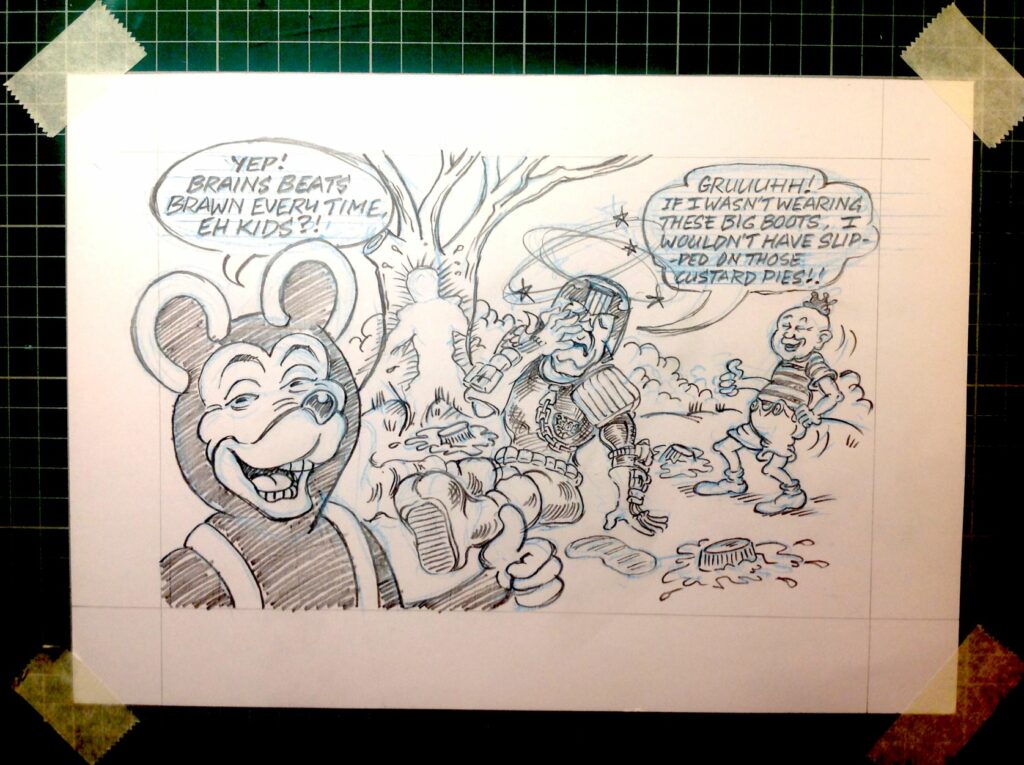
Please describe your last dream in detail…
I usually forget dreams within a few minutes, but it usually oscillates between the ridiculous and the mundane.
I have, however, been a practitioner of ‘lucid dreaming’ for many years and am pretty good at it, but sometimes I dream things which become the basis for creative pursuits.
For example: my story of the ageing punk band ‘Rat Habitz’ in issue three of Gadzooks was entirely taken from a dream. Each twist and turn and even the characters were dreamt acting out the story as you read it.
I had to frantically scribble down the dialogue, with action plot points, over breakfast as I knew I’d forget it all.
Who was your first crush?
…and why were you so infatuated with them?
First Crush? Oooh, you mean in real life or celebrity?
In real life it was a girl in junior school called Julie Ling. She must have been three years older than me but she oozed so much perfection in my little mind at that time.
But then there was Carole.
The broadcasters in the UK didn’t have any programming during the day and so they’d broadcast ‘test’ signals featuring a photo and background music. On one of these test cards was a girl of about my age. She sat before a blackboard playing noughts and crosses with a clown doll. The many hours I spent gazing at her face then. I utterly worshipped her. Those searching eyes, the slight smile. *sighs*
Later in life I discovered she’s called Carole Hersee, and if you’re reading this Carole, “I love you”.
She’s a very skilled costume designer these days, you know?
Does sex change everything?
If you’re in a regular relationship? No, not at all, but if it’s with a friend, a coworker or an unconsenting fish then it’s a big fat “yes”.
Do you have any personal mottos?
There’s a few ideas which help me.
The first would be “Make plans as though you’ll live forever but live like you’ll die today.”
Another would be “Never give up” and finally (but perhaps most importantly): “Be kind. Always.”
Of everything you have done, what would you most like to be remembered for?
I’d like to be remembered fondly, that’s all. Just being remembered at all is enough.
But by creating my art over the years I hope I have made enough Horcrux to live on in some small way, forever.
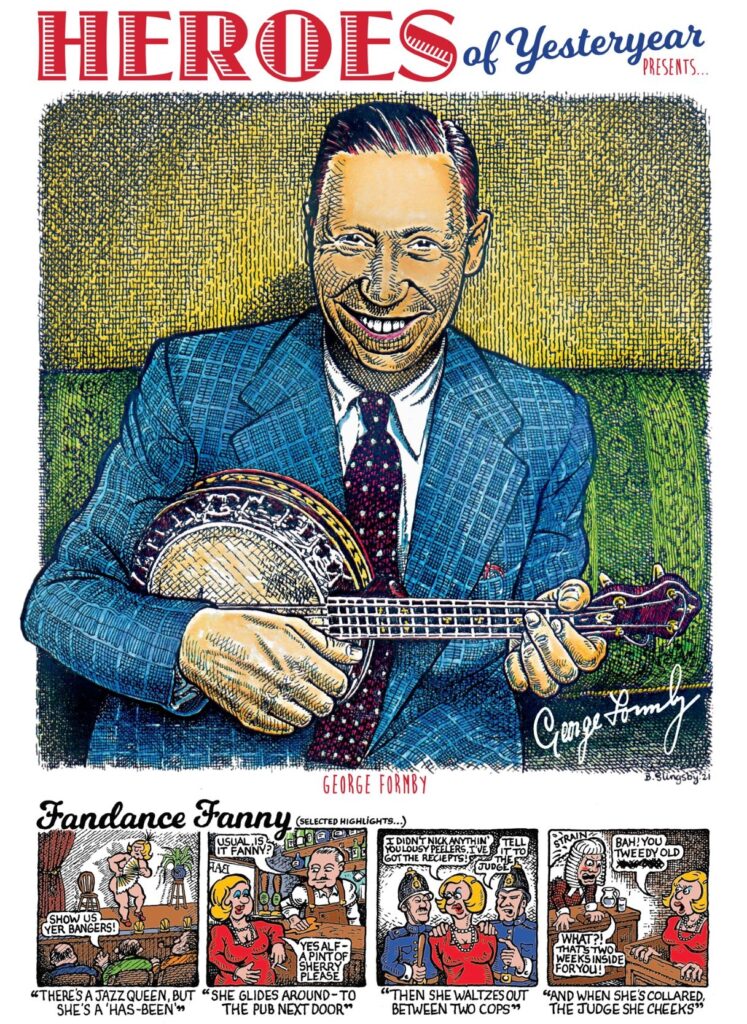
Links
- Gadzooks – Website
- Gadzooks – Online Store
- Gadzooks – Facebook
- J. Bramwell Slingsby – Instagram
